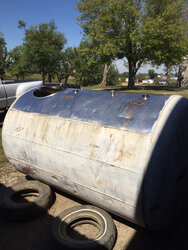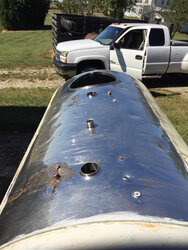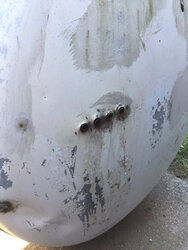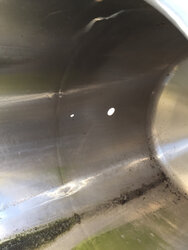So for the last several months I have been putting together on paper a heating system that would hopefully be efficient and would utilize the full potential of the equipment that has been chosen, while also trying to be keep the bottom line at a reasonable level. I have calculated out my needs and I am pretty sure I have done a decent job of determining our heating loads for our house. I have used several resources for these calculations from this website, and I couldn't be more grateful for all information that is on here!
So I have purchased the wood boiler that I feel like will give me the best service and longevity, It hopefully will be delivered within the next week or so. I chose to use the Portage and Main EGR 100 for my heat source. The calculations that I came up with for storage was around 800 gallons, so I have been looking for storage tanks that I could utilize, and I remember a tank that my wife's uncle had sitting outside his barn.
i couldn't believe what I had found, and I think it is going to be a really good option.
I had remember that this tank was stainless but didn't really remember anything else about it, upon looking it over it was an old refrigerated milk tank that had been disassembled and used as a watering tank. It just so happened that it was 800 gallons! Woo Hoo also it was insulated. I was so excited at the find that I didn't even realize there was another benefit to this vessel.
There where 4, 1/2 inch copper lines sticking out the end of the tank that where used for the refrigeration coils that jacket the tank. My question is do you thing these coils would be sufficient for heating the water in the tank?
So I have purchased the wood boiler that I feel like will give me the best service and longevity, It hopefully will be delivered within the next week or so. I chose to use the Portage and Main EGR 100 for my heat source. The calculations that I came up with for storage was around 800 gallons, so I have been looking for storage tanks that I could utilize, and I remember a tank that my wife's uncle had sitting outside his barn.
i couldn't believe what I had found, and I think it is going to be a really good option.
I had remember that this tank was stainless but didn't really remember anything else about it, upon looking it over it was an old refrigerated milk tank that had been disassembled and used as a watering tank. It just so happened that it was 800 gallons! Woo Hoo also it was insulated. I was so excited at the find that I didn't even realize there was another benefit to this vessel.
There where 4, 1/2 inch copper lines sticking out the end of the tank that where used for the refrigeration coils that jacket the tank. My question is do you thing these coils would be sufficient for heating the water in the tank?





